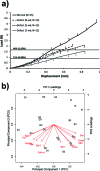Evolving strategies in mechanobiology to more effectively treat damaged musculoskeletal tissues
- PMID: 23445046
- PMCID: PMC3703646
- DOI: 10.1115/1.4023479
Evolving strategies in mechanobiology to more effectively treat damaged musculoskeletal tissues
Abstract
In this paper, we had four primary objectives. (1) We reviewed a brief history of the Lissner award and the individual for whom it is named, H.R. Lissner. We examined the type (musculoskeletal, cardiovascular, and other) and scale (organism to molecular) of research performed by prior Lissner awardees using a hierarchical paradigm adopted at the 2007 Biomechanics Summit of the US National Committee on Biomechanics. (2) We compared the research conducted by the Lissner award winners working in the musculoskeletal (MS) field with the evolution of our MS research and showed similar trends in scale over the past 35 years. (3) We discussed our evolving mechanobiology strategies for treating musculoskeletal injuries by accounting for clinical, biomechanical, and biological considerations. These strategies included studies to determine the function of the anterior cruciate ligament and its graft replacements as well as novel methods to enhance soft tissue healing using tissue engineering, functional tissue engineering, and, more recently, fundamental tissue engineering approaches. (4) We concluded with thoughts about future directions, suggesting grand challenges still facing bioengineers as well as the immense opportunities for young investigators working in musculoskeletal research. Hopefully, these retrospective and prospective analyses will be useful as the ASME Bioengineering Division charts future research directions.
Figures
















References
-
- Butler, D. L. , Goldstein, S. A. , Guldberg, R. E. , Guo, X. E. , Kamm, R. , Laurencin, C. T. , McIntire, L. V. , Mow, V. C. , Nerem, R. M. , Sah, R. L. , Soslowsky, L. J. , Spilker, R. L. , and Tranquillo, R. T. , 2009, “The Impact of Biomechanics in Tissue Engineering and Regenerative Medicine,” Tissue Eng. Part B Rev., 15(4), pp. 477–484.10.1089/ten.teb.2009.0340 - DOI - PMC - PubMed
-
- Dalgaard, P. , 2008, Introductory Statistics With R, Springer, New York, p. 364.
Publication types
MeSH terms
Grants and funding
- R01 AR056660/AR/NIAMS NIH HHS/United States
- R01 AR046574/AR/NIAMS NIH HHS/United States
- R21 EB002361/EB/NIBIB NIH HHS/United States
- AR47054/AR/NIAMS NIH HHS/United States
- T32 GM063483/GM/NIGMS NIH HHS/United States
- R01 AR056943/AR/NIAMS NIH HHS/United States
- EB004859/EB/NIBIB NIH HHS/United States
- R01 AR047054/AR/NIAMS NIH HHS/United States
- AR46574/AR/NIAMS NIH HHS/United States
- AR56660/AR/NIAMS NIH HHS/United States
- EB002361/EB/NIBIB NIH HHS/United States
- AR56943/AR/NIAMS NIH HHS/United States
- R21 EB004859/EB/NIBIB NIH HHS/United States
- T32 GM 063483/GM/NIGMS NIH HHS/United States
LinkOut - more resources
Full Text Sources
Other Literature Sources
Miscellaneous

